How to Install LAMP Stack on Debian 9 Stretch
This tutorial is going to show you how to install Apache, MariaDB and PHP7 (LAMP stack) on Debian 9 stretch. LAMP is the most common web service stack for building dynamic websites and web applications. It’s made up of four components – Linux, Apache, MySQL/MariaDB, PHP – Linux is the operating system; Apache is the web server; MySQL/MariaDB is database; PHP is a server-side scripting language.
All of the four components are free and open-source. However, since MySQL is now owned by Oracle and there’s a chance that Oracle turns it to a closed-source product, we will choose MariaDB instead of MySQL. You can follow this tutorial on a VPS (Virtual Private Server) or on a local Debian 9 computer.
Please note that you need to have root privilege when installing software on Debian. You can add sudo at the beginning of a command, or use su - command to switch to root user.
Step 1: Update Software Packages
Before we install the LAMP stack, it’s a good idea to update repository and software packages. Run the following command on your Debian 9 OS.
sudo apt update sudo apt upgrade
Step 2: Install Apache Web Server
Enter the following command to install Apache Web server. The apache2-utils package will install some useful utilities like Apache HTTP server benchmarking tool (ab).
sudo apt install apache2 apache2-utils
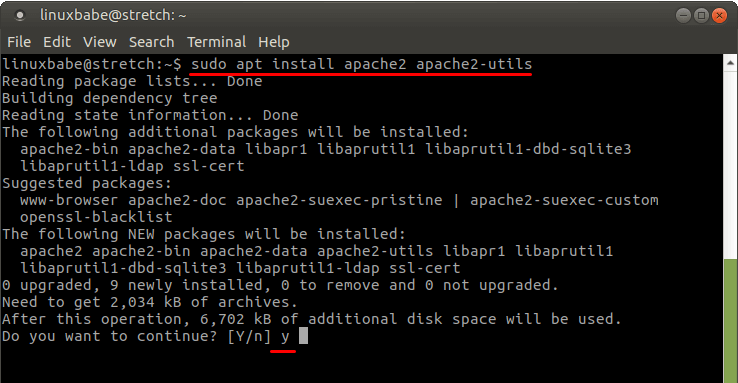
After it’s installed, Apache should be automatically started. Check its status with systemctl.
systemctl status apache2
Output:
● apache2.service - The Apache HTTP Server Loaded: loaded (/lib/systemd/system/apache2.service; enabled; vendor preset: Active: active (running) since Sun 2017-08-13 02:36:48 UTC; 5min ago Main PID: 14463 (apache2) CGroup: /system.slice/apache2.service ├─14463 /usr/sbin/apache2 -k start ├─14465 /usr/sbin/apache2 -k start └─14466 /usr/sbin/apache2 -k start
If it’s not running, use systemctl to start it.
sudo systemctl start apache2
It’s also a good idea to enable Apache to automatically start at boot time.
sudo systemctl enable apache2
Check Apache version:
sudo apache2 -v
Output:
Server version: Apache/2.4.25 (Debian) Server built: 2017-07-18T18:37:33
Now type in the public IP address of your Debian 9 server in the browser address bar. You should see “It works!” Web page, which means Apache Web server is running properly.
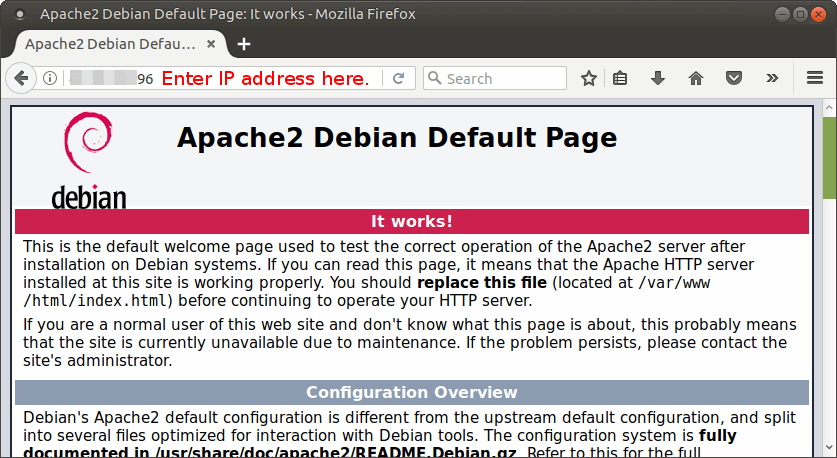
You can use the following commands to fetch the public IP address of your Debian 9 server in the terminal.
sudo apt install curl curl http://icanhazip.com
If you are installing LAMP on your local Debian 9 box, then you should type 127.0.0.1 or localhost in the browser address bar.
Finally, we need to set www-data (Apache user) as the owner of web root directory. By default it’s owned by root user.
sudo chown www-data:www-data /var/www/html/ -R
Step 3: Install MariaDB Database Server
MariaDB is a drop-in replacement for MySQL. Enter the following command to install it on Debian 9.
sudo apt install mariadb-server mariadb-client
MariaDB is recommended over MySQL. As a matter of fact, if you try to install MySQL on Debian 9 using the following command, it will install MariaDB and set MariaDB as the default database server.
sudo apt install mysql-server mysql-client
After it’s installed, MariaDB server should be automatically stared. Use systemctl to check its status.
systemctl status mariadb
Output:
● mariadb.service - MariaDB database server Loaded: loaded (/lib/systemd/system/mariadb.service; enabled; vendor preset: enabled) Active: active (running) since Sun 2017-08-13 03:05:17 UTC; 1min 37s ago Main PID: 16127 (mysqld) Status: "Taking your SQL requests now..." CGroup: /system.slice/mariadb.service └─16127 /usr/sbin/mysqld
If it’s not running, start it with this command:
sudo systemctl start mariadb
To enable MariaDB to automatically start at boot time, run
sudo systemctl enable mariadb
Now run the post installation security script.
sudo mysql_secure_installation
When it asks you to enter MariaDB root password, press Enter key as the root password isn’t set yet. Then enter y to set the root password for MariaDB server.
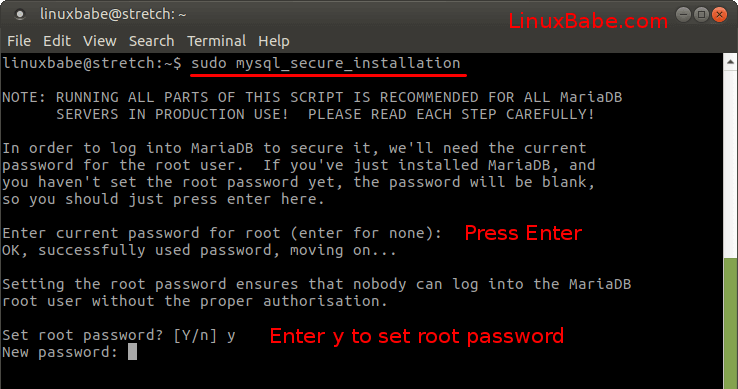
Next, you can just press Enter to answer all remaining questions. This will remove anonymous user, disable remote root login and remove test database. This step is a basic requirement for MariaDB database security.
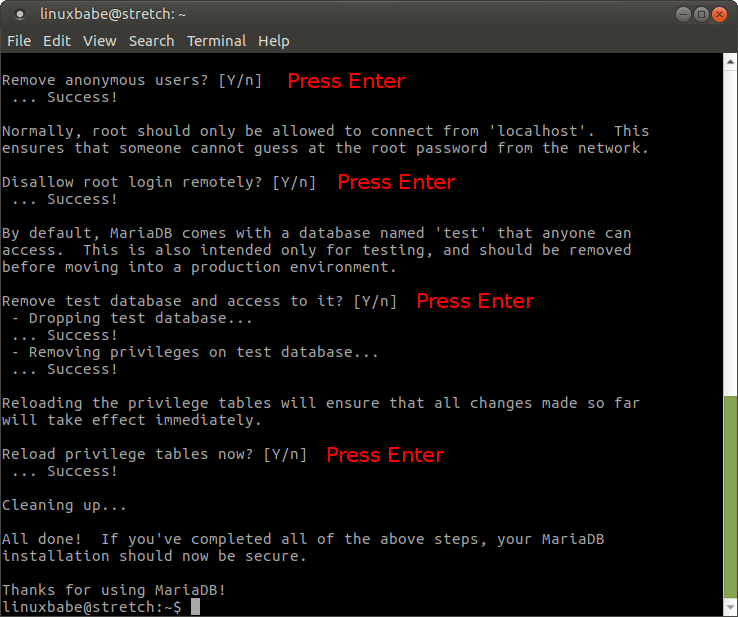
Now you can use the following command to log in to MariaDB server.
sudo mariadb -u root
To exit, run
exit;
Check MariaDB server version information.
mariadb --version
Output:
mariadb Ver 15.1 Distrib 10.1.23-MariaDB, for debian-linux-gnu (x86_64) using readline 5.2
Step 4: Install PHP7
Enter the following command to install PHP7.
sudo apt install php7.0 libapache2-mod-php7.0 php7.0-mysql php-common php7.0-cli php7.0-common php7.0-json php7.0-opcache php7.0-readline
Enable the Apache php7.0 module then restart Apache Web server.
sudo a2enmod php7.0 sudo systemctl restart apache2
Check PHP version information.
php --version
Output:
PHP 7.0.19-1 (cli) (built: May 11 2017 14:04:47) ( NTS )
Copyright (c) 1997-2017 The PHP Group
Zend Engine v3.0.0, Copyright (c) 1998-2017 Zend Technologies
with Zend OPcache v7.0.19-1, Copyright (c) 1999-2017, by Zend Technologies
To test PHP scripts with Apache server, we need to create a info.php file in the Web root directory.
sudo nano /var/www/html/info.php
Paste the following PHP code into the file.
<?php phpinfo(); ?>
Save and close the file. Now in the browser address bar, enter server-ip-address/info.php. Replace sever-ip-address with your actual IP. If you follow this tutorial on your local computer, then type 127.0.0.1/info.php or localhost/info.php.
You should see your server’s PHP information. This means PHP scripts can run properly with Apache web server. You can find that Zend OPcache is enabled.
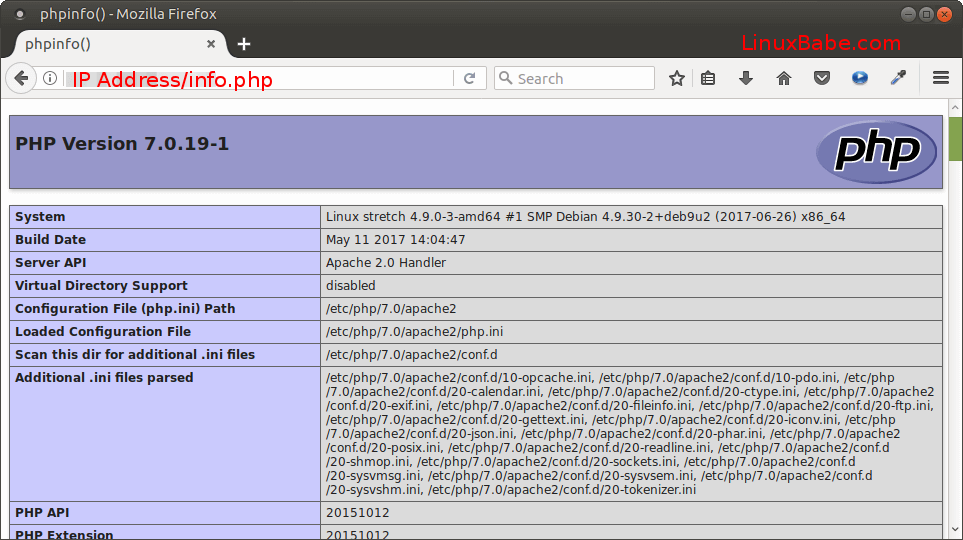
Congrats! You have successfully installed Apache, MariaDB and PHP7 on Debian 9 Stretch. For your server’s security, you should delete info.php file now to prevent prying eyes.
sudo rm /var/www/html/info.php
That’s it! I hope this tutorial helped you install LAMP stack on Debian 9 Stretch. As always, if you found this post useful, then subscribe to our free newsletter to get new tutorials.



Thank you! These steps works fine also on Rapsberry pi 3!
And Orange Pi Zero
I have to Say this is the Time Everything worked. I needed to add PHPMyAdmin and I’m right back where I stated PHPMyAdmin without “Create Users and ”
Privileges”. You did a Great Job Explaining everything. But I could not see how to add Databases or Tables??? Thanks Again for a Great Job. I guess I just can’t get this 2018 Raspberry Pi 3 Stretch Debian to Work PHPMyAdmin. Thanks Joe
Great tutorial for setting up the lamp software. I want to host the database, web etc files on an attached USB drive, but whatever I try I seem to crash the database and can’t get it to open.
Do you have any info that would help me ?
Thanks for your help
First tutorial I’ve found that actually works. Thank you for the help.
Thanx! Had no problem following the above for my Raspberry Pi 3B=.
And actually mananged to move my www folder to the attached usb-drive.
Very, very good indeed, excellent tutorial, thank you for your help, very good indeed !!!!
ibapache2-mod-php7.0 – can’t find this in the sources
Merci beaucoup.
Excellent step by step tutoral, got my LAMP system up and running on my Raspberry Pi 3+ in no time at all.
It would be nice to have a follow on tutoral to show us how to install phpMyAdmin do this as I have managed to break this.
Thank you
Thanks for the guide.
Feel free to use this info to update your page and help other users like myself.
Enter the following command to install PHP7:
Enable the Apache php7.0 module then restart Apache Web server:
PHP 7.2.19-0ubuntu0.18.04.1 (cli) (built: Jun 4 2019 14:48:12) ( NTS ) Copyright (c) 1997-2018 The PHP Group Zend Engine v3.2.0, Copyright (c) 1998-2018 Zend Technologies with Zend OPcache v7.2.19-0ubuntu0.18.04.1, Copyright (c) 1999-2018, by Zend TechnologiesHere is the phpinfo() output for php7.2:
http://drive.google.com/uc?export=view&id=1AU7EobFC9dhoMg4RzRYZQizCCoYkStDR
Thanks!
Debian 9 repository doesn’t include PHP7.2. From your command, I see you are using Ubuntu 18.04, you can check this tutorial: how to install LAMP stack on Ubuntu 18.04.
Thanks for the update, was about to write it myself, when I found your excellent update.
Hi Dear Xiao Guo, according to comments your article is very helpful. So I will follow it surely; but the black hole for me is the address of my local host. Once I put 127.0.0.1 in the browser it changes to 192.x.x.x. Please how can I fix this problem? and how can we install wordpress on localhost after following your present post. Thank you in advance!
You don’t need this line to install php
this works just as well
Thank you a lot Xiao, all works for me at opennebula VM
(provisioned by vagrant) as you wrote.
So wish you Good Luck and Good mood :)!
This is the first time in 3 years since I installed LAMP on Debian 8, last time it was from the digital ocean website and worked great. Since then I had to go to 6 sites to get a smooth install without errors. No errors on this page.
Fantastic job on this, I wish you could add a continuation to add a WordPress site including the database configs as well. I can do it but need to design a site before launching it to the customers’ site. I’m lazy and love the copy and paste way.